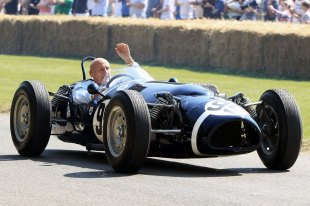
Earlier this year Ferrari unveiled its first ever four-wheel-drive car at the Geneva Motorshow in Switzerland. A proud Luca di Montezemolo beamed in front of a packed audience as the wraps were pulled off the FF, although some suspected Enzo Ferrari was spinning in his grave.
Before then the Italian marque had never bothered powering the front wheels of its cars during its 64-year history, and why would it? Ferrari had always existed to race in Formula One and Formula One has always been dominated by rear-wheel drive cars.
But at one stage in the early sixties, the lifetime's work of an Irish tractor pioneer dared to challenge all that with a quite brilliant piece of engineering. The visionary was Harry Ferguson and his dream was Project 99, the first ever four-wheel-drive Formula One car.
Born out of a feeling of dismay at the British motor industry's failings following the war, the Ferguson P99 drew on the experience of Ferguson himself, Brooklands lap record holder Freddie Dixon and up-and-coming racer Tony Rolt. The plan was to build a lightweight and competitive four-wheel-drive system that would show off the technology's potential for use on the road.
Sadly the timing was flawed, not least because Ferguson died before the P99 hit the track, but also because changing regulations in Formula One meant engine capacity was downsized from 2.5-litres to 1.5-litres, meaning there was less power and therefore less of a need for the improved traction the system offered. What's more Cooper had clearly shown the way forward three years earlier by placing the engine behind the driver and, in the interest of packaging and weight distribution, the P99 was a front-engined car.
As a result, when it made its debut in a field dominated by mid-engined cars in 1961, the Ferguson looked like the kid who had been held back a year at school - and that was a shame because, in truth, it was the most innovative car on the grid.
Ferguson had hired Claude Hill from Aston Martin to package the complex drivetrain's three differentials and connecting drive shafts, and to do so both the engine and driver were offset to accommodate the extra gubbings. Hill left enough space for the 2.5-litre engine, which was still allowed under Inter/Continental regulations, but the 1.5-litre was used in F1 events. Ferguson was also keen to fit in-board Dunlop Maxaret anti-lock brakes, which were also several decades ahead of their time but not to all drivers' tastes.

Rather appropriately the circuit was rain-soaked for the debut of four-wheel-drive at a championship Formula One race, but it was Moss who took the fight to the dominant Ferraris in his little Lotus. In a typically daring performance he worked his way through the field to second, but aquaplaned off the circuit while trying to take the lead from Wolfgang von Trips and soon after retired with brake problems. Fairman, who was having a fairly unremarkable race, was flagged into the pits by the team and Moss took over the P99. He started making rapid progress through the field once more, but was disqualified after receiving a push start in the pits. Nevertheless, Moss was intrigued by the Ferguson and its unusual handling traits and was sure the car had potential in the right hands.
"When you take an ordinary rear-wheel-drive car into a corner, you set the car up in order to pour the power on as early as you can," he told ESPNF1 last year. "You know you've got a set amount of track to slide across and you use up that surface to the maximum. In the Ferguson you didn't drive it that way, you consciously steered it into the corner and you brought the power in. It's much more complicated and less exhilarating, but certainly a more difficult technique to master."
Fortunately Moss was a quick learner, and by the time he hit the track for the International Gold Cup at Oulton Park he had perfected the technique. The race was run to Formula One regulations meaning the less gutsy 1.5-litre Coventry Climax engine was in situ under the bonnet, but the P99 had a secret weapon in some typical English summer drizzle. From second on the grid Moss pulled out a huge lead over the field, which was made up of Lotuses, BRMs Coopers and one JBW, and crossed the line 46 seconds ahead of Jack Brabham. The combination of Moss's wet-weather mastery and all four wheels scrabbling for traction was simply unbeatable around the undulating, tree-lined circuit, and he notched up his fifth and final victory at the Gold Cup.

It was the first and last victory for four-wheel-drive in Formula One as well as the last victory for a front-engined car. Moss was suitably impressed and to this day ranks the P99 among the top cars from that era.
"How would you place it against a 250F? Which would you rather have? It's certainly the fastest car of its time in the wet, although not as easy to drive as a normal rear-wheel-drive car. But if you can learn the style and the turn-in technique in that car it can also be very quick in the dry."
The rest of Formula One did not share Moss's optimism for four-wheel-drive and the P99 next raced at the non-championship 1963 Australian Grand Prix with Graham Hill behind the wheel. The race was not run to Formula One regulations so the 2.5-litre engine was fitted and it finished 6th before taking second place at the Lakeside International. It returned to England in 1964 and won the British hillclimb championship with Peter Westbury at the wheel before being retired in 1968.
BRM, Matra, Lotus and McLaren all dabbled with the Ferguson transmission in the late 1960s and it even found its way onto the Jensen FF road car based on the Interceptor. But it's fair to say that none of its incarnations were as successful as the P99, and in 1982 Ferguson's position as the only manufacturer to win a Formula race was secure when FISA outlawed the technology.
The P99 was an unusual beast in that it was a Formula One car that managed to be both avant-garde and outdated at the same time, with a mixed record of success and failure to match. But despite its pitfalls, it's telling that it has taken 50 years for the sport's biggest name, Ferrari, to catch up.
The P99 still makes regular appearances at the Goodwood Revival and Festival of Speed, where Moss was reunited with it earlier this year. At an auction last year it fetched a bid of £410,000 but was not sold.
Laurence Edmondson is the deputy editor of ESPNF1
© ESPN Sports Media Ltd.
 Laurence Edmondson is deputy editor of ESPNF1 Laurence Edmondson grew up on a Sunday afternoon diet of Ayrton Senna and Nigel Mansell and first stepped in the paddock as a Bridgestone competition finalist in 2005. He worked for ITV-F1 after graduating from university and has been ESPNF1's deputy editor since 2010
Laurence Edmondson is deputy editor of ESPNF1 Laurence Edmondson grew up on a Sunday afternoon diet of Ayrton Senna and Nigel Mansell and first stepped in the paddock as a Bridgestone competition finalist in 2005. He worked for ITV-F1 after graduating from university and has been ESPNF1's deputy editor since 2010

